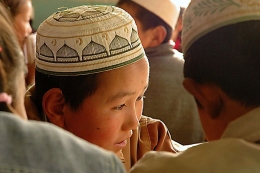The Dongxiangs are an agricultural people. They mainly grow wheat, maize, potatoes, beans and other crops. They have a rich cultural heritage which is mostly seen through its folk songs and narrative poems. Folk songs, which are also known as ‘flowers’ were mainly sung in the past to proclaim hope and to fight against any kind of oppression on the community. Poems and folktales were mainly used to highlight the heroic activities of individuals in the community who overcame various obstacles.
Dongxiang is a Mongolic language spoken in north western China. Other names for the language includes Santa, Tunghsiang and Tung. The Dongxiang language has a number of words that have been borrowed from Han Chinese. Most Dongxiangs also speak Chinese. There are about 20,000 speakers of the language though they do not speak the native Dongxiang but they speak Dongxiang which has been influenced by Mandarin, which Mei Lee Smith, a linguist, refers to as Tangwang, based on the names of the two main villages where the speakers live. Tangwang also includes Arabic and Persian words. Dongxiang does not have any dialects but it has three local varieties. This includes Suonanba, Wangjiaji and Sijiaji. The Latin alphabet has been used for writing the language since 2003. Since Arabic is also widely used among the Dongxiang’s, Arabic script is also used for writing during informal occasions. The Dongxiang language has 7 vowels.
The Dongxiang language derives its names from the geographical region where its speakers live. Historically, the Dongxiangs were not considered Chinese nationals but were merely viewed as a Muslim majority living in the area. They were granted official nationality status after 1949. The areas where the Dongxiangs stay were dominated by mosques. At one time they had a total of 595 mosques and other places of worship. They had 12 imams and 2,000 religious workers who were employed on a full time basis. Ordinary people had to bear the expenses of hiring and maintaining the religious workers. 1 in every 18 households had to provide a religious worker.
